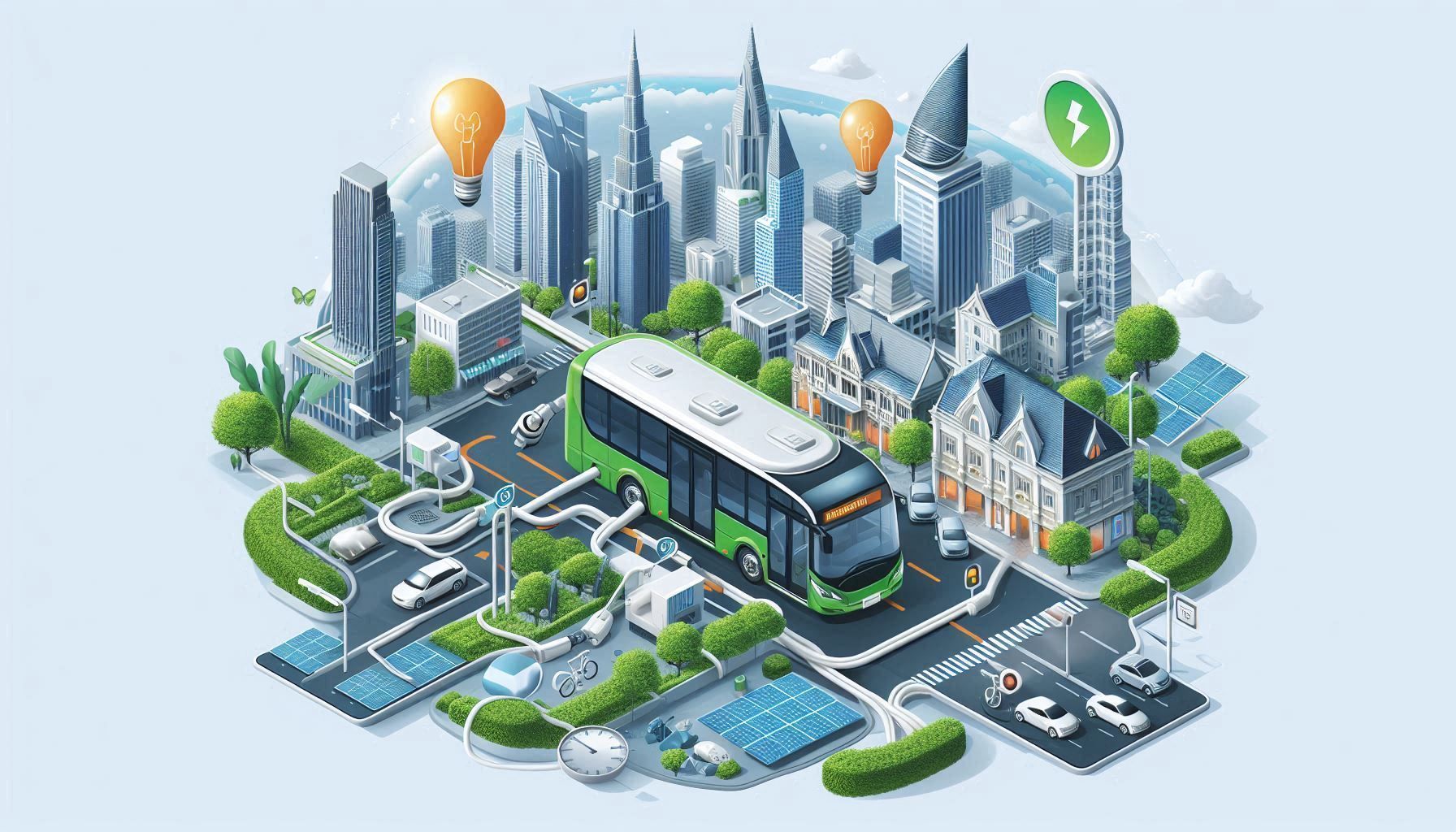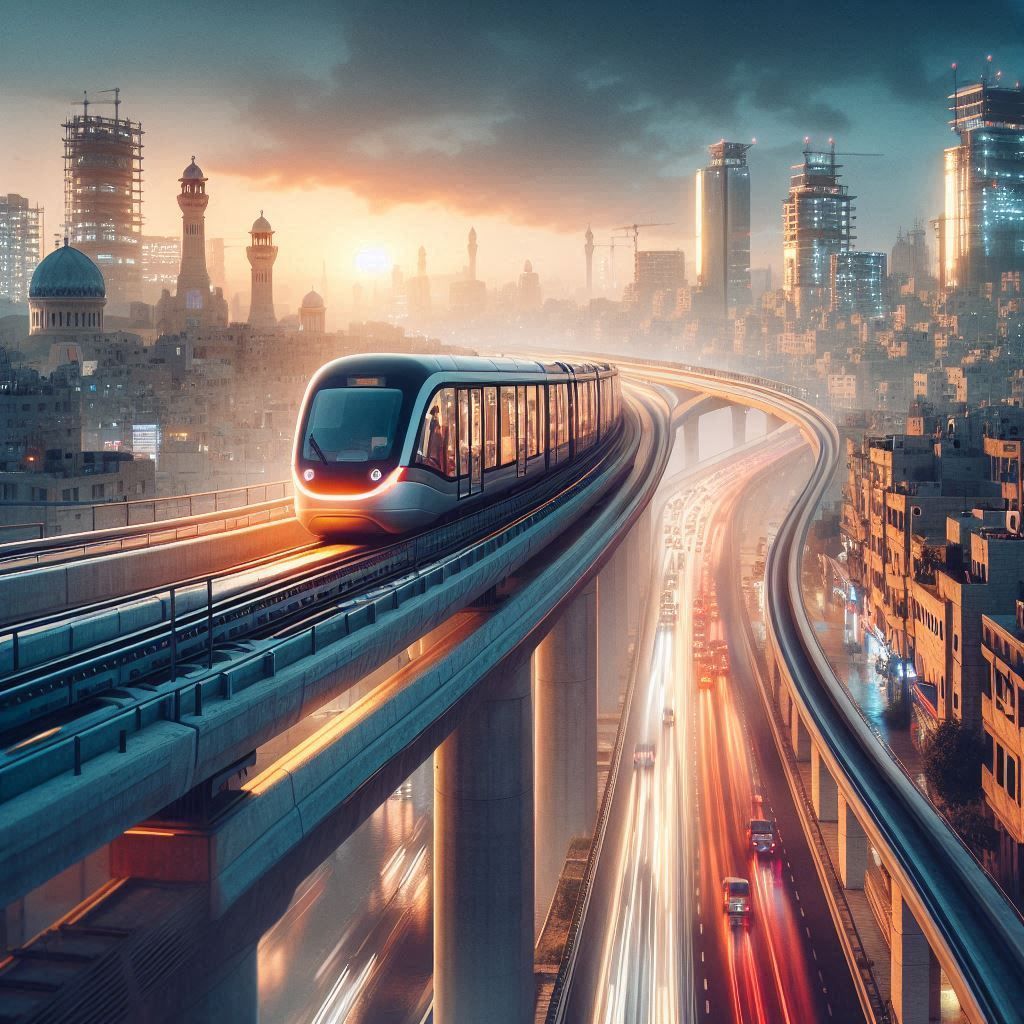By Stephan Keyvino
•
May 18, 2025
The Amman Elevated Light Rail Network is a proposed urban transportation project aimed at improving mobility and reducing traffic congestion in Jordan's capital city. Inspired by the efficiency of metro systems in other major cities, this project envisions a network of elevated light rail lines connecting key areas within Amman and its surrounding suburbs. The elevated design is intended to minimize disruption to existing traffic flow during construction and operation, as well as reduce the challenges associated with underground construction in a city with complex infrastructure. Key Features: Elevated Light Rail Lines: The system would primarily consist of elevated tracks, allowing for smoother traffic flow below and minimizing the need for extensive underground tunneling. Network Integration: The light rail network would be designed to integrate with Amman's existing public transportation infrastructure, including bus routes and potential future expansion of other rail-based systems. Modern Rolling Stock: The system would utilize modern, comfortable, and efficient light rail vehicles with high passenger capacity. Strategic Station Placement: Stations would be strategically located near major residential areas, commercial centers, government buildings, and transportation hubs to maximize accessibility and ridership. Phased Development: The project could be implemented in phases, starting with key high-demand corridors and gradually expanding to cover a wider area. Benefits: Reduced Traffic Congestion: By providing a high-capacity public transportation alternative, the light rail network would help to alleviate traffic congestion on Amman's roads. Improved Air Quality: The use of electric-powered light rail vehicles would contribute to a reduction in air pollution and greenhouse gas emissions. Enhanced Connectivity: The network would improve connectivity between different parts of the city, making it easier for residents to access jobs, education, and other opportunities. Economic Development: Improved transportation infrastructure can stimulate economic growth by facilitating the movement of goods and people. Sustainable Urban Development: The project would support sustainable urban development by promoting the use of public transportation and reducing reliance on private vehicles. Challenges: Financing: Securing adequate funding for a large-scale infrastructure project is a significant challenge. Construction Disruption: Even with an elevated design, construction could cause temporary disruption to traffic and businesses. Public Acceptance: Gaining public acceptance and encouraging a shift from private vehicles to public transportation requires effective communication and awareness campaigns. Right-of-Way Acquisition: Acquiring the necessary land for the elevated tracks and stations, though less complex than underground, still presents challenges. Tripoli Bus Rapid Transit (BRT) System Project Overview: The Tripoli Bus Rapid Transit (BRT) System is a proposed urban transportation project for Libya's capital city. This project aims to provide a cost-effective and efficient solution to improve public transportation and alleviate traffic congestion. The BRT system would utilize dedicated bus lanes, modern high-capacity buses, and intelligent transportation system (ITS) technologies to offer a service that mimics the speed and reliability of a light rail or metro system, but at a lower cost and with greater flexibility. Key Features: Dedicated Bus Lanes: A core element of the BRT system is the creation of dedicated bus lanes, physically separated from regular traffic, to ensure faster and more reliable travel times. High-Capacity Buses: The system would employ a fleet of modern, high-capacity buses designed for rapid boarding and alighting, minimizing dwell times at stations. Intelligent Transportation Systems (ITS): ITS technologies, such as real-time traffic management, priority signaling at intersections, and electronic fare collection, would be used to optimize the flow of buses and provide passengers with accurate and timely information. Station Design: BRT stations would be designed to be accessible, comfortable, and efficient, with features such as level boarding platforms, weather protection, and real-time information displays. Network Design: The BRT network would be designed to connect major residential areas, commercial centers, industrial zones, and transportation hubs within Tripoli. Benefits: Cost-Effectiveness: Compared to rail-based systems, BRT offers a significantly lower capital cost, making it a more feasible option for cities with budget constraints. Faster Implementation: BRT systems can be implemented more quickly than rail projects, allowing for a more rapid improvement in public transportation services. Flexibility: BRT routes can be more easily adjusted or expanded to adapt to changing urban development patterns. Reduced Congestion: By providing a reliable and attractive alternative to private vehicles, BRT can help to reduce traffic congestion and improve air quality. Improved Accessibility: The BRT system would enhance accessibility to jobs, education, healthcare, and other essential services for Tripoli's residents. Challenges: Securing Right-of-Way: Obtaining the necessary right-of-way for dedicated bus lanes can be challenging in a densely populated urban environment. Enforcement: Effective enforcement of dedicated bus lanes is crucial to ensure the system's efficiency and prevent encroachment by other vehicles. Public Perception: Overcoming the perception that buses are inferior to trains and encouraging a shift to public transportation requires a well-designed and marketed system. Operational Efficiency: Maintaining the speed and reliability of the BRT system requires careful planning, traffic management, and operational discipline. Long-Term Sustainability: Ensuring the long-term financial sustainability of the BRT system requires a sound operational model and potentially government subsidies. Chiang Mai Sustainable Urban Mobility Plan with Electric Bus Integration Project Overview: The Chiang Mai Sustainable Urban Mobility Plan is a comprehensive initiative to transform the transportation system in Chiang Mai, Thailand, into one that is environmentally sustainable, efficient, and accessible to all residents and visitors. This plan prioritizes the integration of electric buses into the existing public transportation network, alongside improvements to pedestrian and cycling infrastructure, and the potential future development of light rail or tram lines. The plan emphasizes a holistic approach to urban mobility, aiming to reduce reliance on private vehicles, improve air quality, and enhance the overall quality of life in Chiang Mai. Key Features: Electric Bus Fleet: A key component of the plan is the gradual replacement of the existing diesel bus fleet with a fleet of modern electric buses. This will significantly reduce greenhouse gas emissions and air pollution. Bus Network Optimization: The existing bus network will be redesigned and optimized to provide more efficient and comprehensive coverage of the city, with improved routes, schedules, and frequency. Dedicated Bus Lanes: Dedicated bus lanes will be implemented along key corridors to improve bus speeds and reliability, making public transportation a more attractive option. Pedestrian and Cycling Infrastructure: The plan includes significant investments in improving pedestrian and cycling infrastructure, such as sidewalks, bike lanes, and shared-use paths, to encourage active transportation. Multi-Modal Integration: The plan emphasizes the integration of different modes of transportation, including buses, walking, cycling, and potential future light rail or tram lines, to provide seamless connectivity. Smart Transportation Technologies: The plan will leverage smart transportation technologies, such as real-time information systems, integrated ticketing, and intelligent traffic management, to enhance efficiency and convenience. Benefits: Reduced Air Pollution: The transition to electric buses will significantly reduce air pollution, improving public health and the city's environment. Lower Greenhouse Gas Emissions: Electric buses produce zero tailpipe emissions, contributing to Thailand's efforts to mitigate climate change. Improved Public Health: Reduced air pollution and increased opportunities for active transportation will lead to improved public health outcomes. Enhanced Mobility: A more efficient and integrated transportation system will improve mobility for all residents, making it easier to access jobs, education, and other services. Sustainable Tourism: A sustainable urban mobility plan will enhance Chiang Mai's attractiveness as a tourist destination, promoting environmentally responsible tourism. Challenges: Funding: Securing sufficient funding for the transition to electric buses and the implementation of other infrastructure improvements is a major challenge. Infrastructure Development: Building dedicated bus lanes, improving pedestrian and cycling infrastructure, and potentially developing light rail lines requires significant infrastructure investment and construction. Public Awareness and Behavior Change: Encouraging a shift away from private vehicles and towards public and active transportation requires effective public awareness campaigns and behavioral change initiatives. Coordination and Governance: Successful implementation of the plan requires strong coordination and collaboration among various government agencies, transportation providers, and stakeholders. Technological Transition: The transition to electric buses requires careful planning, including the development of charging infrastructure, training of personnel, and management of battery life cycle.





